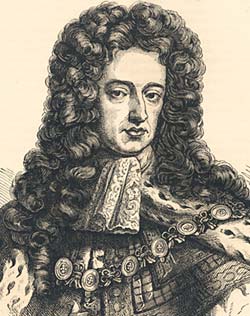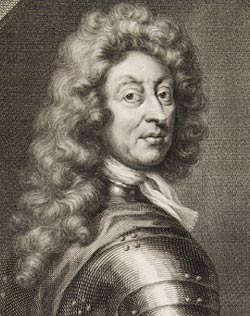Summary of events

Portrait of King William III [William of Orange], 1687
It is not intended to give here a detailed account of the circumstances of the invasion, but merely a framework of events into which each of the documents shown in this Teaching Unit can be fitted.
Early in 1687 William sent his envoy Dykeveld to London on a special mission: to consort with both Anglicans and Nonconformists, and to give Roman Catholics assurance of toleration. He returned to Holland with promises of support from both Whigs and Tories. From the end of 1687, private intelligence was sent to the Prince of Orange's supporters who were preparing the invasion, giving them news of the day to day political situation in England. See Document 1.
February 1687/88
A naval officer reported that his men would not accept any Roman Catholics in charge of the fleet. See Document 3.
March 1687/88
In March 1687/88 the president of Magdalen College, Oxford died. When James imposed a Roman Catholic as his successor the fellows of the College objected. They were deprived of their fellowships and pronounced incapable of holding any church preferments. See Document 2.
April-June 1688
On 27th April 1688, James issued his second Declaration of Indulgence, and ordered it to be read in every church on two successive Sundays. Seven bishops, led by Archbishop Sancroft, petitioned the King to withdraw the order, since they thought he had no right to dispense with the statutes which denied toleration to dissenters. The bishops were sent to the Tower and prosecuted for seditious libel. On 29th June they were found not guilty.
On 10th June a son, James Francis Edward, was born to James and Mary of Modena. The birth of the prince prompted a further mission from Holland to England, ostensibly one of congratulation, but really to make final arrangements for an invitation to William. On the last day of this momentous June the invitation was taken over to Holland by Admiral Russell, dressed as an ordinary seaman. The signatories were Devonshire, Danby, Shrewsbury, Lumley, Compton, Russell, and Henry Sidney. William now knew that his landing would be very different from that of Monmouth in 1685, because he had the support of leaders of the great interests and parties in England.

Portrait of Frederick Herman von Schönberg, 1st Duke of Schomberg, 1688
During July and August 1688, Bentinck was in north Germany raising troops for the invasion. Frederick, elector of Brandenburg, undertook to supply 9,000 men and a famous general, Schomberg. The princely houses of Germany were now combining, under the direction of William, in opposition to France. The critical point came in September when, to the intense relief of William and the Dutch, Louis XIV dispatched his troops against Philippsburg on the middle Rhine, and not against the Netherlands. All through the summer of 1688 very careful preparation went on for the invasion of England. See Document 4.
When James realised that invasion was imminent he backed down hastily. He announced that Catholics would remain incapable of sitting in the House of Commons when the promised Parliament met. A Protestant was put in command of the fleet. The Ecclesiastical Commission was abolished. Some papist lords lieutenant were dismissed. The fellows of Magdalen College were restored. But it was too late. On the last day of September William published a Declaration giving his reasons for the proposed invasion of England, and a few weeks later the States General, the parliament of the Netherlands, pledged their support.
October-November 1688
Under the command of Herbert, William's fleet set sail on 19th October, but was driven back by a storm. On 1st November, however, the 'Protestant Wind' began to blow and a second start was made. No one in England appeared to know for what part of the coast the fleet was bound. This favoured the naval part of William's enterprise and as there were twenty English pilots among the Dutch ships a landing might have been made almost anywhere. See Document 5.
On Guy Fawkes day William landed at Torbay with 11,000 foot and 3,000 horse, for the last successful invasion of England. He assembled his forces at Exeter, but was at first disappointed with the response of the local gentry, who may well have had the fate of Monmouth in mind. See Document 6 and Document 7.
However, he soon received reinforcement from the other side: from Lord Cornbury, Clarendon's son, and, most important of all, from John Churchill, who deserted James on the night of 24th November. That day the King's council of War decided to retreat from Salisbury to London. Meanwhile, Danby seized Yorkshire, Lord Delamere rose in Cheshire, and the Earl of Devonshire, to whom Princess Anne fled on 25th November, in Nottinghamshire. See Document 8 and Document 9
On 27th November, the day after the King's return to London, a body of about fifty peers demanded the summoning of Parliament and the sending of commissioners to treat with William, now on his way from the west. See Document 10.
December 1688
On 1st December the three envoys, Halifax, Nottingham, and Godolphin, met William at Hungerford. James found William's conditions so humiliating that he was confirmed in his recently formed intention of fleeing the country. On 11th December he embarked at Sheerness for France, but his small boat was delayed by the tide at Faversham, and a suspicious band of fishermen boarded her and seized James. The King returned to London on 16th December, but William refused to see him, and the city of London declined to defend him.
The way was left clear for James to make a second escape, and on 23rd December, now completely unnerved, he left England for good. He landed at Ambleteuse, a fishing village near Calais, on Christmas Day, and from there he joined his wife and child at St. Germains where the French King Louis XIV had provided a refuge.
Next page: William of Orange's Itinerary